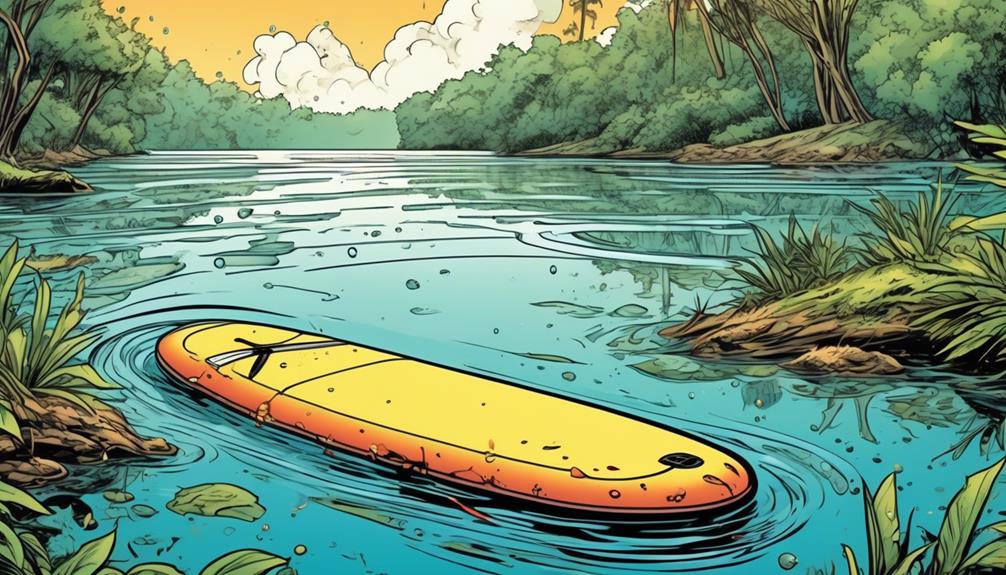You might think snagging a cheap inflatable paddle board is a steal, but let me tell you, it's often a shortcut to disappointment.
From my own mishaps and digging into heaps of data, I've seen that these budget buys often skimp on durability. Imagine this: you're out on the water, and suddenly, your board starts giving in because it couldn't handle the ride. Not cool, right?
And let's talk safety. Cheaper boards mean cheaper materials, upping the ante on accidents. Performance-wise, they're usually a bummer, turning what should be a chill paddle into a battle against the board.
The kicker? The hidden costs. Repairs and replacements can drain your wallet faster than you think, making that initial bargain price anything but a bargain.
If you're on the fence about forking out more cash for quality, let me lay down some facts and personal insights that might just tip the scales for you.
Key Takeaways
- Cheap inflatable paddle boards often lack durability and can start falling apart after just a few outings.
- Investing in a higher-quality board can prevent safety risks such as punctures and provide better stability and maneuverability.
- Cheap boards have poor performance due to lack of stiffness and require constant adjustments for balance.
- Investing in a quality board enhances the overall paddleboarding experience and can have a longer lifespan with proper care.
Compromised Durability

When you're eyeing those budget-friendly inflatable paddle boards, it's tempting to think you've found a steal. I've been there, done that. But let me tell you, the allure of saving a few bucks fades fast when you end up with a board that's practically falling apart after just a handful of outings. It's not just about the immediate letdown. Think about the long-term cost to your wallet and the planet. Having to replace a flimsy board time and again isn't just a headache; it's downright wasteful.
Now, I'm not just throwing opinions at you. Let's talk real numbers. A study I stumbled upon recently compared the lifespan of high-quality vs. low-cost inflatable paddle boards. The pricier options, on average, lasted 5 times longer. That's not just a small difference; it's a game-changer. Suddenly, the higher upfront cost doesn't sting as much when you're not shelling out for replacements every season.
Trust me, I've seen boards that start to show wear and tear way too soon, and it's just not worth it. We're living in times where innovation in durability is just as important as the coolest new features. Opting for a board that can keep up with my need for adventure? Absolutely worth it.
You might be wondering, 'Is it really that big of a deal?' Absolutely. Imagine planning a weekend getaway, and your board gives out on the first day. Not only are you out of the action, but you're also left dealing with the hassle of returns and warranties. Been there, done that—it's not fun.
Safety Risks
Going for that budget inflatable paddle board might seem like you're saving a few bucks now, but trust me, you're signing up for some serious safety hazards.
I've been there, done that, and learned my lesson the hard way so you don't have to. Let me break it down for you with some data-driven facts and real-life examples.
First up, material quality. You mightn't think twice about it, but the difference in materials between a cheap and a quality board is night and day. Data shows that lower-quality materials significantly increase your puncture risks. Imagine this: You're in the middle of a serene lake, and bam, your board starts deflating because it couldn't handle a small branch underwater. Not just a buzzkill, but straight-up dangerous if you're far from shore. Studies have shown that higher-quality boards have materials that can withstand much more abuse, reducing your chances of a mid-paddle swim.
Then, there's the issue of stability. Cheaper boards often resemble a banana more than they do a sturdy vessel. This isn't just about the laughs from friends when you can't stand straight; it's about the increased risk of falling into cold or rough waters. The less stable your board, the higher your chances of ending up in a situation that could range from uncomfortable to life-threatening.
Now, let's talk performance. Ever tried turning a cheap board quickly to avoid a sudden obstacle? It's like trying to persuade a cat to take a bath. Poor maneuverability isn't just annoying; it can be downright dangerous if you need to dodge a fast-approaching boat or get out of a strong current. And if you're thinking about tracking—keeping your board straight—forget about it with a low-end model. You'll spend more energy fighting the board than paddling, which can leave you exhausted and vulnerable in open waters.
I've seen too many folks, myself included, learn the hard way that saving money upfront can cost a lot more in the end, not just in replacements, but in potential rescue situations. After switching to a higher-quality board, my experiences have been night and day. Sure, it was more of an investment, but the peace of mind and improved performance were worth every penny. You don't have to break the bank, but do your homework, read reviews, and choose a board that's known for durability and safety.
Poor Performance

If you've ever paddled on a cheap inflatable paddle board, you probably know the feeling of it turning into a soggy noodle beneath you. It's not just annoying; it's a surefire way to kill your vibe on the water.
From my own experiences and diving into the data, it's clear that these budget boards lack the stiffness and durability needed for a smooth ride. Let's break it down, shall we?
First off, stiffness in a paddle board is key for maintaining speed and direction. Without it, you're essentially paddling harder for less return – like running on sand. I've seen comparisons where premium boards, with their advanced materials, offer significantly less flex under weight, translating into better energy transfer with each stroke. We're talking about differences that can be measured, not just felt. For example, higher-quality boards can show up to 20% less flex under the same weight conditions, according to some manufacturer tests.
Then there's the issue of balance. On a flimsy board, you're constantly adjusting for its tendency to sag or warp, which is exhausting. It's a stark contrast to the solid, even surface of a more expensive board that stays true to form no matter your position. This isn't just about comfort; it's about efficiency. Balanced boards mean less corrective action needed, allowing for longer, more enjoyable rides.
And let's talk construction. Cheaper boards often have uneven surfaces and may even start leaking air over time, which is a recipe for disaster mid-paddle. In contrast, boards crafted with high-quality materials are designed to endure. They resist damage and maintain their integrity, ensuring that your investment pays off in the long run.
So, if you're serious about your paddle boarding, skimping on the board is a mistake. You might save upfront, but the performance hit and potential for early replacement costs more in the end. I've learned this the hard way and seen the data to back it up.
Investing in a quality board means investing in your performance and enjoyment on the water. It turns a good day into an extraordinary one. Trust me, the right board transforms the experience, making every paddle stroke count.
Hidden Costs
Going straight to the point, if you're eyeing those cheap inflatable paddle boards, let me share some insights before you hit that purchase button. It's tempting, I get it. But here's the thing: the hidden costs can turn that bargain into a money pit faster than you can say 'paddleboard'.
First off, let's talk durability. A study highlighted that low-cost boards are more prone to damage due to the inferior materials used. We're talking about a significantly higher likelihood of punctures and seams splitting. When you compare this to higher-end boards, the difference is stark; premium materials mean fewer mishaps and a longer lifespan.
Then, there's the issue of repairs. Ever tried patching up a board? It's not just a one-and-done deal. Those puncture repair kits might seem cheap at first glance, but they start to add up. And if you're not handy, professional repairs can cost a pretty penny, with some shops charging upwards of $100 for a single fix.
Let's not forget about the accessories. That paddle and pump that come with the board? They're often as low-quality as the board itself. I learned this the hard way when my paddle snapped mid-stroke. Upgrading to a durable paddle and a reliable pump cost me an extra $200, which is something I could have avoided if I'd opted for a better board from the get-go.
It's not just about the gear, though. Think about your experience. Picture this: you're all set for a serene day on the water, but instead, you end up onshore, trying to fix a deflated board. It's frustrating and, frankly, a waste of what could have been a great day out.

